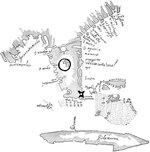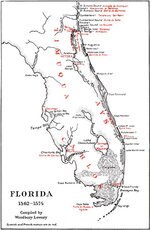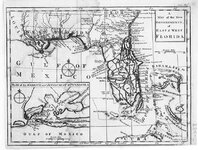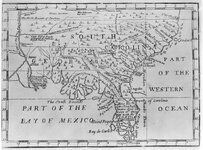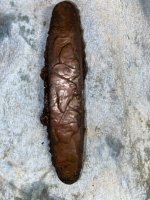You are using an out of date browser. It may not display this or other websites correctly.
You should upgrade or use an alternative browser.
You should upgrade or use an alternative browser.
Older Spanish Shipwrecks
- Thread starter bigscoop
- Start date
bigscoop
Gold Member
- Jun 4, 2010
- 13,373
- 8,689
- Detector(s) used
- Older blue Excal with full mods, Equinox 800.
- Primary Interest:
- All Treasure Hunting
- Thread starter
- #22
From The Memoir of
Hernando D’Escalante Fontaneda
Written in 1575, nearly ten years after his rescue (1565) after having living seventeen years among the Indian tribes of south Florida (wrecked there about 1548.);
“The country of the kings of Ais and of Jeaga is very poor. It contains neither gold or silver mines, and, to tell the truth, it is only the sea which enriches it, since many vessels laden with precious metals are shipwrecked there; such as the Farfan, and the Howker. On board of the latter was Anton Granado and Captain Juan Christobal, whom the natives made slaves; and killed Don Martin De Guzman, Captain Hernando De Andino, and Juan Orvis. On board of this ship were the sons of Alonso De Mesa and their uncle. They were all rich, and I the poorest among them, yet had twenty-five pesos of fine gold. My father and my mother had both served his Majesty in Peru, and subsequently in Carthagena, were they established a colony. I, as well as one of my brothers, was born there. They were sending us to Spain to be educated when we were shipwrecked on the Florida coast; as well as the fleet from New Spain, commanded by the son of Don Pedro Menendez.”
“That he was only a sailor on one of the shipwrecked vessels of the fleet, and ignorant of the fate of the others until after he had talked with the Indians who went armed to the coast of Ais and returned with very considerable riches, in the form of ingots of gold, sacks of Spanish coins, and quantities of merchandise.”
“I will say no more now on this subject, but proceed to speak of the wealth which the Indians found in bars of gold and Mexican jewelry belonging to the shipwrecked passengers, amounting to more than a million. The chief retained the best part of it for himself, and divided the remainder among the Indians of Ais, of Jeaga, of Guacata, of Mayajuaca, and of Mayaca. Most of the vessels or caravels, as I stated before, which had been shipwrecked there were from Cuba and Honduras, and going in search of the river Jordan, which explains how the Indians of Ais, of Jeaga, and the Guardgumve Islands became so enriched by the sea and not by the land.”
Narrative of Le Moyne, 1564;
This after speaking with two unidentified shipwreck survivors who had survived among the Indians of south Florida;
They also reported that he (King Carlos) possessed a great store of gold and silver, and that he kept it in a certain village in a pit not less then a man's height in depth, and as large as a cask; and that, if I could make my way to that place with a hundred arquebusiers, they could put all that wealth into my hands besides which I might obtain from the richer of the natives. They said further that, when women met for the purpose of dancing, they were, hanging at their girdles, flat plates of gold as large as quoits, and in such numbers that the weight fatigued and inconvenienced them in dancing; and that the men were similarly loaded. The greater part of all of this wealth, they were of the opinion, came from Spanish ships, of which numbers are wrecked in that straight; the rest from the trade between the king and other chiefs in the neighborhood.”
There is no evidence that any of this accumulated wealth was ever recovered. However, what is clear is that numerous richly laden ships did wreck on the coast of Florida during the early and mid 1500’s and that they were close enough to shore to be easily salvaged by the south Florida Indians. Also take notice that both accounts reference “fleets” when speaking of these wrecks. Thus far, to my knowledge, records have not provided details of wrecked “fleets” on the Florida coast prior to 1555 but it is certain that they did occur as early as the mid to late 1840’s (Fontaneda was a survivor of one such wrecked fleet in the late 1840’s.) Also keep in mind that these vessels were much smaller ships, “caravels” that most likely, due to their shallower draft, would have been swept closer to shore atop the increased storm swells.
It’s also interesting to note that a great deal of this treasure passed through the hands of the Ais & Jeaga and deep into the mainland, and possibly even reaching as far as the west coast Indian villages. The Jeaga were south of the Ais, which serves to provide a possible hint that many of these wrecks took place further south then that of the discovered 1715 wrecks. It is a vast expanse of ocean and beach but we do know there is a lot of history and wealth out there, and a great deal of it is very likely closer to shore then we realize, some of it already known to be on shore. All trace of these ships is probably gone except for the more resilient cargoes they have left behind. But clearly it is there, somewhere, and it is near certain that is there in great quantity. One day a researcher will be busy examining the documents in the archives and they are going to come across that first fantastic document or clue, I have little doubt in that. I also have little doubt that the preceding discovery will dwarf that of the 1715 fleet if laws don’t prevent it’s discovery and salvaging. When one considers the era in question and the preceding conquest that took place, there is little doubt of the extraordinary discoveries that await.
Hernando D’Escalante Fontaneda
Written in 1575, nearly ten years after his rescue (1565) after having living seventeen years among the Indian tribes of south Florida (wrecked there about 1548.);
“The country of the kings of Ais and of Jeaga is very poor. It contains neither gold or silver mines, and, to tell the truth, it is only the sea which enriches it, since many vessels laden with precious metals are shipwrecked there; such as the Farfan, and the Howker. On board of the latter was Anton Granado and Captain Juan Christobal, whom the natives made slaves; and killed Don Martin De Guzman, Captain Hernando De Andino, and Juan Orvis. On board of this ship were the sons of Alonso De Mesa and their uncle. They were all rich, and I the poorest among them, yet had twenty-five pesos of fine gold. My father and my mother had both served his Majesty in Peru, and subsequently in Carthagena, were they established a colony. I, as well as one of my brothers, was born there. They were sending us to Spain to be educated when we were shipwrecked on the Florida coast; as well as the fleet from New Spain, commanded by the son of Don Pedro Menendez.”
“That he was only a sailor on one of the shipwrecked vessels of the fleet, and ignorant of the fate of the others until after he had talked with the Indians who went armed to the coast of Ais and returned with very considerable riches, in the form of ingots of gold, sacks of Spanish coins, and quantities of merchandise.”
“I will say no more now on this subject, but proceed to speak of the wealth which the Indians found in bars of gold and Mexican jewelry belonging to the shipwrecked passengers, amounting to more than a million. The chief retained the best part of it for himself, and divided the remainder among the Indians of Ais, of Jeaga, of Guacata, of Mayajuaca, and of Mayaca. Most of the vessels or caravels, as I stated before, which had been shipwrecked there were from Cuba and Honduras, and going in search of the river Jordan, which explains how the Indians of Ais, of Jeaga, and the Guardgumve Islands became so enriched by the sea and not by the land.”
Narrative of Le Moyne, 1564;
This after speaking with two unidentified shipwreck survivors who had survived among the Indians of south Florida;
They also reported that he (King Carlos) possessed a great store of gold and silver, and that he kept it in a certain village in a pit not less then a man's height in depth, and as large as a cask; and that, if I could make my way to that place with a hundred arquebusiers, they could put all that wealth into my hands besides which I might obtain from the richer of the natives. They said further that, when women met for the purpose of dancing, they were, hanging at their girdles, flat plates of gold as large as quoits, and in such numbers that the weight fatigued and inconvenienced them in dancing; and that the men were similarly loaded. The greater part of all of this wealth, they were of the opinion, came from Spanish ships, of which numbers are wrecked in that straight; the rest from the trade between the king and other chiefs in the neighborhood.”
There is no evidence that any of this accumulated wealth was ever recovered. However, what is clear is that numerous richly laden ships did wreck on the coast of Florida during the early and mid 1500’s and that they were close enough to shore to be easily salvaged by the south Florida Indians. Also take notice that both accounts reference “fleets” when speaking of these wrecks. Thus far, to my knowledge, records have not provided details of wrecked “fleets” on the Florida coast prior to 1555 but it is certain that they did occur as early as the mid to late 1840’s (Fontaneda was a survivor of one such wrecked fleet in the late 1840’s.) Also keep in mind that these vessels were much smaller ships, “caravels” that most likely, due to their shallower draft, would have been swept closer to shore atop the increased storm swells.
It’s also interesting to note that a great deal of this treasure passed through the hands of the Ais & Jeaga and deep into the mainland, and possibly even reaching as far as the west coast Indian villages. The Jeaga were south of the Ais, which serves to provide a possible hint that many of these wrecks took place further south then that of the discovered 1715 wrecks. It is a vast expanse of ocean and beach but we do know there is a lot of history and wealth out there, and a great deal of it is very likely closer to shore then we realize, some of it already known to be on shore. All trace of these ships is probably gone except for the more resilient cargoes they have left behind. But clearly it is there, somewhere, and it is near certain that is there in great quantity. One day a researcher will be busy examining the documents in the archives and they are going to come across that first fantastic document or clue, I have little doubt in that. I also have little doubt that the preceding discovery will dwarf that of the 1715 fleet if laws don’t prevent it’s discovery and salvaging. When one considers the era in question and the preceding conquest that took place, there is little doubt of the extraordinary discoveries that await.
Chagy
Bronze Member
King Carlos was the King of The Calusas mainly in the west coast of Fl and the mid and upper Fl Keys Fontaneda was held captive by the Calusas so it is very possible that he wrecked somewhere in the Mid- to Upper Keys....
Also when Pedro Menendez de Aviles came to Fl in 1565 he traveled to the Keys to met with King Carlos. Later he married King Carlos sister. I believe on this same trip is when he also met Fontaneda.
Also when Pedro Menendez de Aviles came to Fl in 1565 he traveled to the Keys to met with King Carlos. Later he married King Carlos sister. I believe on this same trip is when he also met Fontaneda.
Last edited:
bigscoop
Gold Member
- Jun 4, 2010
- 13,373
- 8,689
- Detector(s) used
- Older blue Excal with full mods, Equinox 800.
- Primary Interest:
- All Treasure Hunting
- Thread starter
- #24
In 1696 an Ais chief was forced to disclose the location of a cache that contained 100 pieces of eight, the proximity of this cache was recorded at 27 degrees, 8 minutes. Of course, this was the result of a recent wreck. But it does give an actual location of the Ais activity.
Coins dating 1543 have been unearthed in this same region, also other Spanish artifacts dating to this period.
The coastal dividing line between the Ais and the Jeaga, as close as i can figure from historical references, was south of Jupiter inlet. References suggest both tribes were active in the salvaging of wrecks upon their coast during the period in question.
Also, from what I have been able to reference, King Carlos had many faces over the years, the name often being associated with the presiding king at the time rather then the individual. King Carlos was also said to be located on the west coast, near Tampa Bay. Another suggest he was located near the great lake of the river (Lake Okeechobee).
Most of the shipwreck accounts that reference the Ais looting locate these wrecks near the "bar of Ais", or "south of Cape Canaveral". Others reference place them in "the Florida straights", etc.
Fontaneda references many of the ships as having come from Cuba and Honduras.
I am not 100% sure as to the exact location of the island of "Guardgumve", however, somewhere within the scope of these three points rest a lot of treasure from these earlier wrecks. i.e., Bar of Ais, Jeaga region, and Guardgumve.
Coins dating 1543 have been unearthed in this same region, also other Spanish artifacts dating to this period.
The coastal dividing line between the Ais and the Jeaga, as close as i can figure from historical references, was south of Jupiter inlet. References suggest both tribes were active in the salvaging of wrecks upon their coast during the period in question.
Also, from what I have been able to reference, King Carlos had many faces over the years, the name often being associated with the presiding king at the time rather then the individual. King Carlos was also said to be located on the west coast, near Tampa Bay. Another suggest he was located near the great lake of the river (Lake Okeechobee).
Most of the shipwreck accounts that reference the Ais looting locate these wrecks near the "bar of Ais", or "south of Cape Canaveral". Others reference place them in "the Florida straights", etc.
Fontaneda references many of the ships as having come from Cuba and Honduras.
I am not 100% sure as to the exact location of the island of "Guardgumve", however, somewhere within the scope of these three points rest a lot of treasure from these earlier wrecks. i.e., Bar of Ais, Jeaga region, and Guardgumve.
Last edited:
Chagy
Bronze Member
I have read acounts were the treasure was divided among the tribes Calusa, jega and Ais.....Anyways what are you trying to find the wrecks or the treasure that the indians had? if the wrecks are in shallow waters the Indians may have recovered most of it...I have read accounts were the Indians had recovered over a million pesos...
bigscoop
Gold Member
- Jun 4, 2010
- 13,373
- 8,689
- Detector(s) used
- Older blue Excal with full mods, Equinox 800.
- Primary Interest:
- All Treasure Hunting
- Thread starter
- #26
I have read acounts were the treasure was divided among the tribes Calusa, jega and Ais.....Anyways what are you trying to find the wrecks or the treasure that the indians had? if the wrecks are in shallow waters the Indians may have recovered most of it...I have read accounts were the Indians had recovered over a million pesos...
"Either one". My goal is sort of two faceted, right now I'm still in the process of trying to zero in the most likely starting points. This has been a pet-project of mine for many years. Finding something from the 1715 fleet would be indeed fabulous, but to actually find something from 150 years or more before that.....well.....for me, it's just an incredibly fascinating personal pursuit. Will I ever realize that pursuit? Probably not. But I'm not going to let that likelihood stop me. These things are out there waiting to found, and so I seek.
 It's just one of those mysteries that drives me.
It's just one of those mysteries that drives me.Bigscoop,
Are you a diver? I have a particular interest in the early wrecks also...I have been ploting the Ais villiages in Brevard and Indian river county...and have zeroed in on a partcular location in Brevard...it is between the old Pentoaya villiage and the New Ais villiage documented by Mexia in 1605.
If you would like to bounce some ideas back and forth pm me.
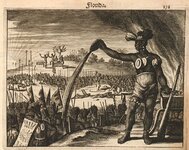
noticed the decapitated heads on poles
and arms and legs in the backgound
Are you a diver? I have a particular interest in the early wrecks also...I have been ploting the Ais villiages in Brevard and Indian river county...and have zeroed in on a partcular location in Brevard...it is between the old Pentoaya villiage and the New Ais villiage documented by Mexia in 1605.
If you would like to bounce some ideas back and forth pm me.

noticed the decapitated heads on poles
and arms and legs in the backgound
wetfly
Full Member
- Aug 8, 2012
- 235
- 163
Just happened upon this thread and the island
Guardgumve has been charted on several early maps as being matacumbe key in the upper keys. It was one of the only keys to have a natural fresh water source. This whole Subject has fascinated me for as long as I can remember! As a kid I had always wished that someone would make a movie about the memoirs of fontenada! I mean how many documented accounts of native American life in Florida from that time period are there?? I have been researching an reading anything relating to the subject and came across this one on the Internet! Very interesting read! Also very interesting old maps and charts of the period tie everything together!!
http://digitalcollections.fiu.edu/tequesta/files/1950/50_1_02.pdf
http://www.digitalhistory.uh.edu/maps/maps.cfm
Some really great charts and maps from as early as 1500 on that map site link!!
Guardgumve has been charted on several early maps as being matacumbe key in the upper keys. It was one of the only keys to have a natural fresh water source. This whole Subject has fascinated me for as long as I can remember! As a kid I had always wished that someone would make a movie about the memoirs of fontenada! I mean how many documented accounts of native American life in Florida from that time period are there?? I have been researching an reading anything relating to the subject and came across this one on the Internet! Very interesting read! Also very interesting old maps and charts of the period tie everything together!!
http://digitalcollections.fiu.edu/tequesta/files/1950/50_1_02.pdf
http://www.digitalhistory.uh.edu/maps/maps.cfm
Some really great charts and maps from as early as 1500 on that map site link!!
Attachments
Dell Winders
Sr. Member
I need to find more on these wrecks.
In my opinion, what researchers fail to consider is the location of the shore line during the time period of their research. During the 1500's, 1700's the shoreline extended much farther out than the present day shore line. Wrecks that are now found a half mile off shore may have wrecked close, or washed up on the beach of the earlier shore line making it easy for the Indians to salvage it's cargo and relocate it. Dell
wetfly
Full Member
- Aug 8, 2012
- 235
- 163
That is absolutly true dell as you can see from early nautical charts of the keys where there once were actual dry land islands along the reef line! For example, looe key, east and western sambo's, and western dry rocks were dry land islands about 200 or so years ago! As for finding a map of those springs GB, I too would love to get ahold of one!! Although the closest thing I've come to that is a chart of the keys with anchors printed on it in locations for early anchorages up and down the keys! This is a link to a chart by captain David Braddock in 1756 of the entire keys with anchorage points marked off key largo, key west and the tortugas-- it also talks about watering holes on key biscayne !! Definatly a good read and worth a look!!
http://www.woodenshipsironmen.com/dcbchart.htm
http://www.woodenshipsironmen.com/dcbchart.htm
FloridaSon
Sr. Member
- Sep 29, 2018
- 320
- 564
- 🥇 Banner finds
- 1
- Detector(s) used
- Garrett, Equinox 800
- Primary Interest:
- Beach & Shallow Water Hunting
"Either one". My goal is sort of two faceted, right now I'm still in the process of trying to zero in the most likely starting points. This has been a pet-project of mine for many years. Finding something from the 1715 fleet would be indeed fabulous, but to actually find something from 150 years or more before that.....well.....for me, it's just an incredibly fascinating personal pursuit. Will I ever realize that pursuit? Probably not. But I'm not going to let that likelihood stop me. These things are out there waiting to found, and so I seek.It's just one of those mysteries that drives me.
Bigscoop - are you still pursuing this? Regards
Top Member Reactions
-
 2363
2363 -
 1134
1134 -
 1049
1049 -
 884
884 -
 824
824 -
 801
801 -
 766
766 -
 753
753 -
 610
610 -
 502
502 -
 497
497 -
 472
472 -
 468
468 -
 425
425 -
 396
396 -
O
372
-
 371
371 -
 371
371 -
 369
369 -
 368
368
Users who are viewing this thread
Total: 2 (members: 0, guests: 2)


